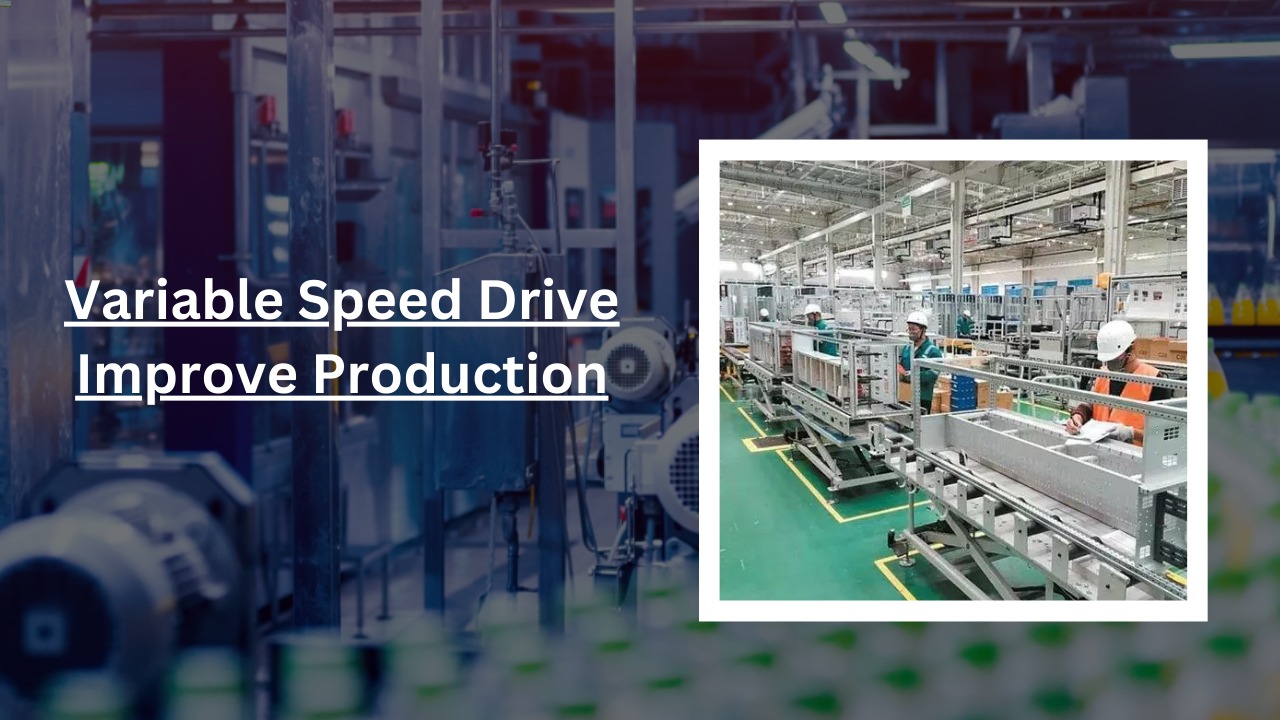A variable speed drive (VSD), also known as a variable frequency drive (VFD), can improve output in a number of ways by providing precise control over motor speed and power usage. Several ways a VSD can enhance industrial processes are listed below:
1. Energy Efficiency:
One of the key benefits of using a VSD is the reduction of energy consumption. Thanks to VSDs, motors may operate at a variety of speeds. Allowing the speed and power consumption of the motor to be adjusted to suit the needs of the production process. By reducing speed when full power is not need, the VSD can significantly reduce energy consumption and utility expenses.
- Motor Matching: Conventional fixed-speed motors operate at a given speed regardless of the power needed. This could lead to energy waste, especially if the process requires modification. With a VSD, the motor speed can be precisely controlled to match the desired load. This motor matching feature minimizes energy loss and consumption by ensuring that the motor operates at its greatest level of efficiency.
Ckeck: Allen Bradley 22F-A8P0N103 PowerFlex 4M AC Drive
2. Process Optimization:
Various production procedures commonly call for variable speeds or torque levels. A VSD allows operators to precisely adjust the rotational speed of the motor in order to improve the process parameters. By changing the pace, the production process can modify to more closely match the desire output, leading to improve quality, reduce waste, and increase productivity.
- Speed Control: Using VSDs, operators can adjust the motor speed to meet the unique requirements of the process. This versatility enables fine-tuning of the production parameters, including flow rates, mixing intensities, and conveyor speeds. By adjusting the motor speed, the process may more precisely match to the intend output. Which also ensures consistency in quality, reduces waste, and increases overall productivity.
- Flexible Operations: Many industrial processes are subject to variations in output demand, raw material characteristics, or operational conditions. Because VSDs enable dynamic speed alterations, operators are able to respond quickly to these changes. The ability to rapidly change the motor speed ensures optimum performance and productivity. Even in a variety of conditions without requiring manual modifications or complicated mechanical setups.
3. Soft Starting:
When starting an electric motor, a VSD can ramp up the speed gradually rather than supplying full power at once. By preventing mechanical stress, this soft-start feature reduces wear and tear on the motor and any connected equipment. Furthermore, it lessens the likelihood of sudden voltage drops or electrical surges. It could interfere with other activities or damage delicate components.
- Reduced Mechanical Stress: When starting a motor, using full voltage and current quickly could create mechanical strain on the motor and any connected equipment. By gradually ramping up the voltage and current to the motor, soft starting lowers the stress and wear on mechanical components. Such as belts, gears, couplings, and bearings. Because mechanical stress is reduce with soft starting, equipment lasts longer and requires fewer maintenance and repair visits.
Read: Rockwell Automation PowerFlex 4M AC Drive
4. Speed Control and Flexibility:
In applications where the motor speed needs to altere frequently or dynamically, a VSD provides precise speed control. By instantly modifying the motor speed, manufacturing processes can quickly respond to shifting demands, variations in raw materials, or specific operating circumstances. This flexibility improves responsiveness, cuts down on downtime during adjustments, and promotes overall production.
- Precise Speed Control: VSDs allow for fine regulation of motor speed. Instead of running at a fix speed, the motor’s rotational speed can adjust to better fit the needs of the process. In order to optimise production elements like flow rates, mixing intensities, or conveyor speeds. The speed can then be precisely regulated. By maintaining the ideal pace, VSDs provide consistent product quality, reduce variation, and increase overall process effectiveness.
5. Enhanced Motor Protection:
VSDs frequently come with safety features that help protect the connected motor built in. These precautions could include overheat detection, voltage/frequency monitoring, and overload detection. By constantly tracking the motor’s parameters, a VSD helps prevent damage brought on by excessive loads, voltage swings, or unusual operating conditions. This protection lengthens the motor’s lifespan and reduces the likelihood of unanticipated failures.
- Overload Protection: Features for overload detection are typically seen in VSDs. They continuously check the motor’s current and compare it to the predetermined limits. The VSD can sound an alarm or implement safety measures like slowing down or stopping the motor if the current exceeds the set level. Through provide overload protection, overheating, motor damage, and other risks are prevented.
- Voltage and Frequency Monitoring: VSDs monitor the voltage and frequency of the motor’s power source. If there are abnormal voltage fluctuations or deviations from the predetermined frequency. The VSD can take remedial action to protect the motor. It may automatically adjust the voltage or frequency to guarantee stable motor operation within the permitted range. This feature helps guard against motor damage caused by frequency variations, voltage dips, or spikes.
6. Noise Reduction:
Continuous full-speed operation of a motor can produce audible noise levels. It is possible to use a VSD to modify motor speed to reduce noise. And it improve the working environment for employees. Higher comfort, better focus, and greater job satisfaction could arise from this.
In summary, A variable speed drive (VSD) can improve energy efficiency, provide process optimization, provide precise speed control, boost motor protection. And reduce noise levels in industrial activities. Using VSDs can lead to cost savings, higher productivity, and a more dependable and sustainable manufacturing environment.
Asteam Techno Solutions Pvt. Ltd. is the latest in the field of suppliers for automation parts and components. We mediate between the manufacturers and you, in order to facilitate your work. We trade with many manufacturers such as the most famous brands including Allen Bradley, Phoenix Contact, Moxa, Schneider Electrics, Omron, Siemens, Vipa and many more. We are ready to be the best and most qualitative provider of industrial spare parts. Do not hesitate to contact us – you simply send us an inquiry once the code of the part that you need.












